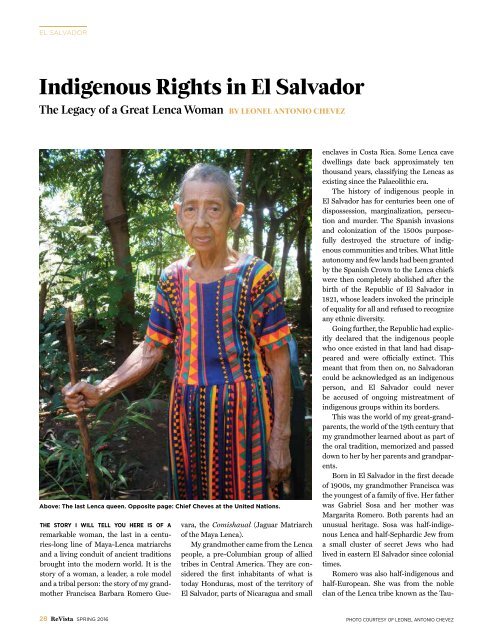EL SALVADOR
8clowSgZh
8clowSgZh
Create successful ePaper yourself
Turn your PDF publications into a flip-book with our unique Google optimized e-Paper software.
<strong>EL</strong> <strong>SALVADOR</strong><br />
Indigenous Rights in El Salvador<br />
The Legacy of a Great Lenca Woman BY LEON<strong>EL</strong> ANTONIO CHEVEZ<br />
Above: The last Lenca queen. Opposite page: Chief Cheves at the United Nations.<br />
THE STORY I WILL T<strong>EL</strong>L YOU HERE IS OF A<br />
remarkable woman, the last in a centuries-long<br />
line of Maya-Lenca matriarchs<br />
and a living conduit of ancient traditions<br />
brought into the modern world. It is the<br />
story of a woman, a leader, a role model<br />
and a tribal person: the story of my grandmother<br />
Francisca Barbara Romero Guevara,<br />
the Comishaual (Jaguar Matriarch<br />
of the Maya Lenca).<br />
My grandmother came from the Lenca<br />
people, a pre-Columbian group of allied<br />
tribes in Central America. They are considered<br />
the first inhabitants of what is<br />
today Honduras, most of the territory of<br />
El Salvador, parts of Nicaragua and small<br />
enclaves in Costa Rica. Some Lenca cave<br />
dwellings date back approximately ten<br />
thousand years, classifying the Lencas as<br />
existing since the Palaeolithic era.<br />
The history of indigenous people in<br />
El Salvador has for centuries been one of<br />
dispossession, marginalization, persecution<br />
and murder. The Spanish invasions<br />
and colonization of the 1500s purposefully<br />
destroyed the structure of indigenous<br />
communities and tribes. What little<br />
autonomy and few lands had been granted<br />
by the Spanish Crown to the Lenca chiefs<br />
were then completely abolished after the<br />
birth of the Republic of El Salvador in<br />
1821, whose leaders invoked the principle<br />
of equality for all and refused to recognize<br />
any ethnic diversity.<br />
Going further, the Republic had explicitly<br />
declared that the indigenous people<br />
who once existed in that land had disappeared<br />
and were officially extinct. This<br />
meant that from then on, no Salvadoran<br />
could be acknowledged as an indigenous<br />
person, and El Salvador could never<br />
be accused of ongoing mistreatment of<br />
indigenous groups within its borders.<br />
This was the world of my great-grandparents,<br />
the world of the 19th century that<br />
my grandmother learned about as part of<br />
the oral tradition, memorized and passed<br />
down to her by her parents and grandparents.<br />
Born in El Salvador in the first decade<br />
of 1900s, my grandmother Francisca was<br />
the youngest of a family of five. Her father<br />
was Gabriel Sosa and her mother was<br />
Margarita Romero. Both parents had an<br />
unusual heritage. Sosa was half-indigenous<br />
Lenca and half-Sephardic Jew from<br />
a small cluster of secret Jews who had<br />
lived in eastern El Salvador since colonial<br />
times.<br />
Romero was also half-indigenous and<br />
half-European. She was from the noble<br />
clan of the Lenca tribe known as the Tau-<br />
28 ReVista SPRING 2016 PHOTO COURTESY OF LEON<strong>EL</strong> ANTONIO CHEVEZ


